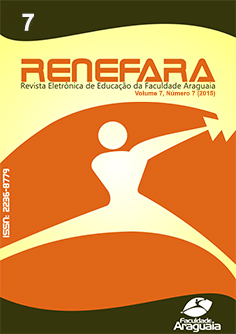CARACTERIZAÇÃO MORFOANATOMIA E HISTOQUÍMICA DE Hyptis rubicunda POHL ex BENTH. (LAMIACEAE), OCORRENTE NA SERRA DOURADA, GOIÁS, BRASIL
Keywords:
tricomas tectores e glandulares, venação semicraspedódroma, hipoestomaticaAbstract
As Lamiaceae são reconhecidas por sua importância econômica e etnofarmacológica. O gênero Hyptis pertence às Lamiaceae com cerca de 400 espécies, no Brasil são encontradas 202 espécies, sendo 146 endêmicas. O objetivo desse estudo foi caracterizar morfologicamente e anatomicamente o caule e a folha da espécie Hyptis rubicunda Pohl ex Benth., visando auxiliar na caracterização desta espécie e contribuir com novos dados para o grupo. A espécie foi coletada na Serra Dourada, Mossâmedes, Goiás. Para o estudo anatômico utilizaram-se as técnicas usuais em anatomia vegetal, realizando-se secções paradérmicas da lâmina foliar, além de secções transversais da do caule e folha. O padrão de venação é do tipo craspedódroma semicraspedódroma com nervuras até a quarta ordem. A lâmina foliar é hipoestomáticas, com estômatos do tipo diaíticos e raros anisoíticos. Em ambas as faces do limbo ocorrem tricomas tectores uni e pluricelulares, glandulares, peltado e capitados. O mesofilo dorsiventral; nervura principal em secção transversal apresenta contorno plano- convexo. O Sistema vascular é do tipo colateral, organizado em arco aberto, presença de hidatódios marginais. O peíolo e o caule possuem tricomas. Os testes histoquímicos detectaram-se lipídios principalmente nos tricomas glandulares, compostos fenólicos nos tricomas tectores, amido e sílica na região das células basais dos tricomas tectores. Os dados obtidos neste trabalho contribuirão para o estabelecimento de parâmetros de identidade botânica, podendo fornecer subsídios para a taxonomia, bem como compreender as estratégias de adaptação da espécie ao seu ambiente natural.Downloads
Issue
Section
License
The copyright of the published articles will be transferred to the Uniaaraguaia Magazine, allowing its subsequent reproduction as transcription and with due citation of source. In the event of acceptance and before the publication of the article, the plaintiff (s) shall write a statement formally transferring copyright to the magazine.
The author may also print and distribute copies of his article, provided that he mentions that the rights belong to the Uniaaraguaia Magazine.
Author rights include the right to reproduce in full or partly by any means, distribute this article, including figures and photographs.
By submitting originals to the Uniaaraguaia magazine, the author or authors express agreement with the following terms:
a) Authors maintain copyright and grant Uniaraguaia magazine the right of first publication, with the work simultaneously licensed under the Creative Commons Attribution license that allows the sharing of work with recognition of the authorship and initial publication in this magazine.
b) Authors are authorized to assume additional contracts separately, for non-expiration distribution of the work version published in this magazine (eg publish in institutional repository or as book chapter), with recognition of authorship and initial publication in this journal.
c) Authors are allowed and are encouraged to publish and distribute their work online (eg in institutional repositories or on their personal page) to any point before or during the editorial process, as this can generate productive changes as well as increase the impact and citation of published work.

